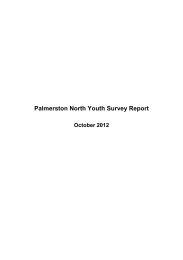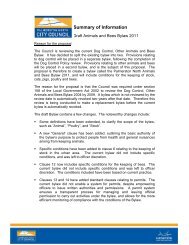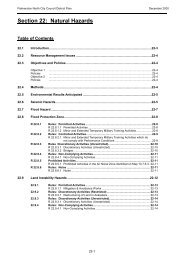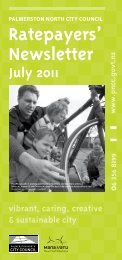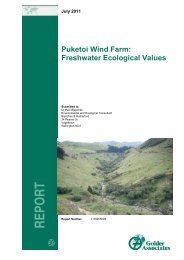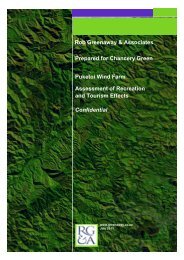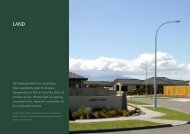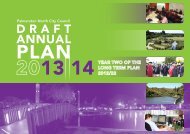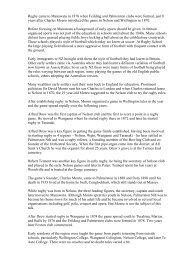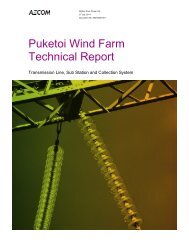Part 1 - Palmerston North City Council
Part 1 - Palmerston North City Council
Part 1 - Palmerston North City Council
You also want an ePaper? Increase the reach of your titles
YUMPU automatically turns print PDFs into web optimized ePapers that Google loves.
gemconsulting<br />
3.3 Monitoring and Maintenance<br />
Once the works are completed they will be maintained in perpetuity as a Lower Manawatu Scheme asset.<br />
It will be necessary to monitor the rock lining and groyne on a regular basis, and particularly after any<br />
floods, to ensure that any faults are noted and rectified as required.<br />
The rock lining is designed to be ‘self‐healing’ so that if any rocks are displaced from the lining due to<br />
undermining, the rocks higher up the lining can slip down to take their place and continue to provide<br />
protection of the river bank. The lining can then be topped up from above after the event. For this reason,<br />
vehicular access will be required along the top of the lining and from time to time it is likely that machinery<br />
will be present to carry out repairs and to top up the lining as required.<br />
It is proposed to leave approximately 300 tonnes of rock at Stockpile Site 3 for future maintenance of the<br />
rock lining and groyne. This will reduce the need to transport rock across the Manawatu River. However, it<br />
is likely that machinery will need to cross the river to carry out any maintenance required and as such, it is<br />
proposed to leave the ford in place after the construction. While this structure will likely erode over time, it<br />
is expected to be a simple exercise to bring it back up to useable/crossable state by topping it up with<br />
gravel as or when required.<br />
The ford will also be used to top up the Stockpile Site 3 if required in the future. This will involve the<br />
stockpiling of the rock on the right bank first and then transporting it over the river. It is expected that this<br />
would not occur more than once every five to ten years and would require 15 loads resulting in 30 river<br />
crossings.<br />
4 ALTERNATIVES<br />
4.1 Management of Erosion at ANZAC Cliffs<br />
Several alternatives to manage the erosion at the ANZAC Park cliff area have been considered over recent<br />
years. These include the following:<br />
Realign the river now<br />
This is the option that has been decided upon and for which resource consent is now being sought. Within<br />
this option three proposals have been considered.<br />
The first option considered was to realign the river on a gentler curve by locating it hard against the right<br />
bank. This would involve considerably more excavations and construction of a longer rock lining.<br />
Investigations also proved that there would be issues with an artesian aquifer underneath the site. Also,<br />
the financial cost of undertaking this option was prohibitive.<br />
The second proposal was somewhat less ambitious, and consisted of a rock lining of some 560 metres long<br />
in a similar position to that proposed now but extending upstream an additional 100 metres. Until recently<br />
this was the preferred option. However, there are several reasons why this option has not been adopted.<br />
Surveys of the gravel beach indicated that there would be insufficient gravel available for the back fill<br />
required. Rising costs of transport require that as much material as possible is sourced from the site and<br />
carting in gravel from elsewhere would exceed available budgets. The extra 100 metres of rock lining would<br />
also add significantly to the amount of rock required to be transported to the site. The Regional <strong>Council</strong> has<br />
been unable to gain access to the river, for construction, from the left bank, meaning that all rock for the<br />
lining now has to be transported through residential areas of town and forwarded across the river. Again<br />
this has added to the overall costs of the project and also causes some additional disturbance to residents<br />
and the river. The Mangaotane Stream is also problematic with it currently joining the Manawatu River<br />
behind the proposed rock lining thereby requiring it to be realigned so that it joins the river upstream of the<br />
lining. The longer lining made this difficult to achieve.<br />
7



